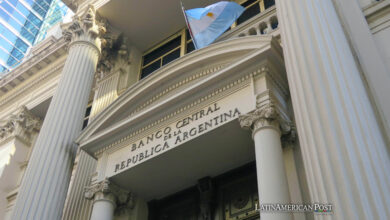The response to the pandemic has been uneven in the region in terms of infections, vaccination, and economic effects. We analyze the situation a year later.

We analyze the actions of the different governments and the impact on the region since the arrival of COVID-19. Photo: Google
LatinAmerican Post | Luis Angel Hernández Liborio
Listen to this article
Leer en español: La realidad de Latinoamérica a un año de la declaración de pandemia
On March 11, 2020, Tedros Adhanom Ghebreyesus, director of the World Health Organization, confirmed what the world feared most: Covid-19 was officially declared a pandemic. Latin America had a few weeks of uncertainty before the arrival of the first case that occurred in Brazil on February 26. Since then, the response to the pandemic has been uneven, we analyze the actions of the different governments and the impact on the region.
One of the regions with the highest mortality
Latin America is the second region with the most deaths caused by Covid-19 only after Europe. According to data from France 24 , Latin America this week exceeded 700,000 official cases. Brazil is, so far, the country most affected by the pandemic with 11 million confirmed cases and 266,000 deaths, followed closely by Mexico with 190,923 deaths in 2.1 million cases, according to data updated from Worldometers as of March 9. These two countries are the ones that "lead" the number of deaths in the region, however Colombia (2.2 million cases / 60 thousand deaths), Argentina (2.1 million cases / 53 thousand deaths), and Peru ( 1.3 million cases / 47 thousand deaths).
How did these countries get to those numbers?
The response to the pandemic was very different between each country, Brazil and Mexico. Both governments have been characterized by their visceral politics and almost skeptical handling of the pandemic. Bolsonaro refused to wear the mask for a long time until he was forced by a judge. López Obrador continues not to use it (except on rare occasions such as during his visit to Donald Trump).
Mientras tanto el presidente de #Brasil Jair Bolsonaro vs cubrebocas #Covid_19 pic.twitter.com/5kTW1WLhwU
— José Carlos Reyes (@JCharlys31) August 14, 2020
Similarly, Peru (238,559), Colombia (229,234), Argentina (170,386), Brazil (133,900), and Mexico (43,330) are the countries with the lowest test rate per million inhabitants. Peru and Colombia bet in the first wave for total and partial closures and even fines for those who violated the confinement, not so in cases like Mexico, a country dependent on tourism. The government of Mexico did not declare mandatory confinement, sanctions, mandatory use of face masks (until the pandemic was advanced), tests, border or airport closures, that is, the country remained (and remains) fully open without the need to submit negative evidence or quarantine.
In contrast, Chile, Bolivia, Paraguay, Uruguay, and Venezuela have the lowest number of cases and deaths in the region. However, it is important to consider the size of your population. Even so, the case of Chile stands out, which leads the number of tests per million inhabitants with 510,661. It also applied mandatory confinement for months that helped reduce the exponential increase in cases as in other countries.
You can also read: How will the absence of opposition influence Nayib Bukele's politics?
"The Chilean miracle" in vaccination
The response in Latin America was uneven, no country has been able until now, to produce its own vaccine, which led them to depend on those produced in other parts of the world. This left the region in the crossfire between pharmaceutical companies and governments seeking to monopolize production.
Chile vacuna a 23% de población y ofrece colaborar con LatAm https://t.co/HZYT0BxqXr pic.twitter.com/To6reIlKjo
— Pulso Online (@pulso_mx) March 2, 2021
The COVAX mechanism, created to distribute vaccines to disadvantaged countries, plans to provide 26 million doses from March to May of this year for Latin America. According to information from Deutsche Welle, only Cuba has its own vaccines in the last phase of development. Colombia was the first Latin American country to receive vaccines from this mechanism with 117 thousand doses of Pfizer-BioNTech.
Chile y Covid-19, las cosas se están haciendo bien.
Ayer 8 de marzo, Chile superó a Israel y es el país que más rápido está vacunando en el mundo (promedio diario última semana) pic.twitter.com/zxN0C19dFc
— APRA ARAUCANíA (@aprachile) March 9, 2021
Mexico is the country with the most purchase agreements and the one that has authorized the most vaccines, ensuring more than 230 million doses, according to information from The Economist. However, so far it has barely received 5 million doses and has applied 2.8 million vaccines, according to Infobae data. The slow supply of vaccines has been one of the biggest criticisms of the López Obrador government, which has been overshadowed by the so-called "Chilean Miracle", which has managed to apply almost 4 million doses, representing 18% of its population. Brazil, with 8.8 million doses applied, has barely vaccinated 3.2% of its population. According to Statista data, Argentina (1.8%), Peru (0.9%), Costa Rica (2%) and Colombia (0.3%) are still very far from Chile. Between the slow supply and the internal division over the purchase of vaccines, these countries are still behind in their vaccination plans.
Same pandemic, different economies
Covid-19 put the world's largest economies in crisis, so the impact on Latin America looked apocalyptic. The Economic Commission for Latin America and the Caribbean (ECLAC) indicates that Latin American economies already had low growth, a mere 0.3% on average in the last five years prior to the pandemic, according to the BBC. The fragility of these economies allowed the impact to be greater. Venezuela had the worst performance with a 30% drop in GDP. ECLAC predicts that when the recovery phase begins, this economy will be the only one that does not grow.
CEPAL presentará nuevas cifras sobre el impacto de la pandemia del COVID-19 en pobreza, desigualdad y empleo en la regiónhttps://t.co/K55GeHWSOZ pic.twitter.com/iN8cuYZqlf
— Asodegua La Guajira (@AsodeguaG) March 4, 2021
Peru's GDP fell 12.9% despite the fact that it was the country with the greatest economic stimuli in the region, the strength of the Peruvian economy has kept it afloat, and ECLAC expects it to be one of the countries that will recover the fastest. Mexico had a 9% drop in GDP, but this can be understood by the uncertainty that had been generated by the López Obrador government, which also decided not to create any type of economic or fiscal stimulus for the country's companies, despite this overview, ECLAC expects a growth of 3.8% by 2021.
Perú enfrenta una importante caída económica.
Perú atraviesa una de sus peores caídas de la economía en los últimos años, donde se perdió poco más del 47% del empleo formal.#Perú #Covid #Desempleo #Fuerza #Apoyo #Economia #Corrupción #AcciónSocial pic.twitter.com/MzqQAJR8xe— ACCION SOCIAL (@accionsocial22) June 25, 2020
The Colombian economy contracted 5.5% in 2020, according to data from Procolombia, also stating that the World Bank expects a recovery in 2021 with the growth of 3.6%, exceeding the 2.8% average expected for Latin America. The vaccination that Chile has accelerated like no other country will bear fruit this year, where it is shaping up to be the one that recovers the fastest according to El País. Like Peru, the Chilean government gave economic stimuli and allowed citizens to access their pension resources, the only difficulty that Chile may face this year in economic matters is the one generated by the uncertainty due to the elections of its constituent convention who will write the new Magna Carta.





